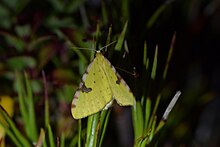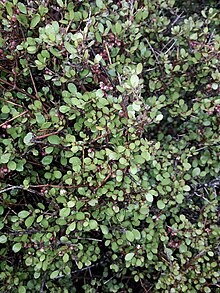| Epiphryne xanthaspis | |
|---|---|

| |
| Female | |

| |
| Male | |
| Scientific classification | |
| Domain: | Eukaryota |
| Kingdom: | Animalia |
| Phylum: | Arthropoda |
| Class: | Insecta |
| Order: | Lepidoptera |
| Family: | Geometridae |
| Genus: | Epiphryne |
| Species: | E. xanthaspis |
| Binomial name | |
| Epiphryne xanthaspis (Meyrick, 1883) | |
| Synonyms | |
| |
Epiphryne xanthaspis, also known as the Aristotelia Looper, is a moth in the family Geometridae. This species was first described by Edward Meyrick in 1883. It is endemic to New Zealand and can be found from the central North Island southward to the bottom of the South Island. The preferred habitat of this species is sub-alpine native forest. The larval hosts of E. xanthaspis are plants in the genus Aristotelia and include Aristotelia fruticosa. Adults are on the wing from December until March.
Taxonomy
This species was first described by Edward Meyrick in 1883 using specimens collected at Lake Guyon by R. W. Fereday and named Hermione xanthaspis. Meyrick gave a fuller description of the species in 1884. In 1886 Meyrick renamed the genus in to which he had previously assigned this species Aulopola. George Hudson described and illustrated this species both in his 1898 book New Zealand moths and butterflies (Macro-lepidoptera) as well as in his 1928 book The butterflies and moths of New Zealand. In both publications Hudson used the name Venusia xanthaspis for this species. In 1988 J. S. Dugdale discussed this species under the name Epiphryne xanthaspis. The male lectotype specimen is held at the Natural History Museum, London.
Description

Meyrick described this species as follows:
Male, female.—27–30 mm. Forewings moderate; hindmargin hardly bowed; bright yellow; costa suffused with reddish-fuscous, and marked with five short oblique darker marks; a transverse oval dark fuscous spot in disc above middle, sometimes touching costal suffusion; a transverse row of very faint fuscous dots from last costal mark. Hindwings moderate, hindmargin slightly projecting in middle; very pale whitish-yellow; two strongly curved transverse rows of very faint fuscous dots between middle and hindmargin.
Distribution
Epiphryne xanthaspis is endemic to New Zealand and can be found from the central North Island south. As well as its type locality, this species has been observed at Mount Ruapehu and in the Tararua Ranges in the North Island as well as at Mount Arthur, Otira, and the Routeburn Valley.
Habitat and hosts

The preferred habitat of this species is sub-alpine native forest. The larval hosts of E. xanthaspis are plant species in the genus Aristotelia and include Aristotelia fruticosa. Adult moths have been recorded as pollinating the flowers of Olearia virgata.
Behaviour
The adults of this species are on the wing from December to March. Adults are regarded as being 'medium fliers' with intermedia flight powers and remain active in light breezes. Adults are attracted to light.
References
- ^ Gordon, Dennis P., ed. (2010). New Zealand inventory of biodiversity: Kingdom animalia: chaetognatha, ecdysozoa, ichnofossils. Vol. 2. p. 459. ISBN 978-1-877257-93-3. OCLC 973607714. OL 25288394M. Wikidata Q45922947.
- ^ "Epiphryne xanthaspis (Meyrick, 1883)". www.nzor.org.nz. Retrieved 2022-04-27.
- Edward Meyrick (September 1883). "Monograph of New Zealand Geometrina". New Zealand Journal of Science. 1: 526. Wikidata Q110691894.
- ^ Edward Meyrick (May 1884). "A Monograph of the New Zealand Geometrina". Transactions and Proceedings of the New Zealand Institute. 16: 61. ISSN 1176-6158. Wikidata Q109615359.
- Edward Meyrick (May 1886). "Notes on Nomenclature of New Zealand". Transactions and Proceedings of the New Zealand Institute. 18: 184. ISSN 1176-6158. Wikidata Q109615399.
- George Vernon Hudson (1898), New Zealand moths and butterflies (Macro-lepidoptera), Illustrator: George Hudson, London, p. 54, doi:10.5962/BHL.TITLE.7912, OCLC 980865393, Wikidata Q19073637
{{citation}}: CS1 maint: location missing publisher (link) - ^ Hudson, G. V. (1928), The butterflies and moths of New Zealand, Illustrator: George Hudson, Wellington: Ferguson and Osborn Limited, p. 106, LCCN 88133764, OCLC 25449322, Wikidata Q58593286
- ^ Dugdale , J. S. (23 September 1988). "Lepidoptera - annotated catalogue, and keys to family-group taxa". Fauna of New Zealand. 14. Department of Scientific and Industrial Research: 179. doi:10.7931/J2/FNZ.14. ISSN 0111-5383. Wikidata Q45083134.
- ^ Andrew Crowe (2017). Which New Zealand insect?. Auckland: Penguin Books. p. 23. ISBN 978-0-14-100636-9. OL 3731007M. Wikidata Q105622564.
- ^ Graeme White (1991). "The Changing Abundance of Moths in a Tussock Grassland, 1962- 1989, and 50-Year to 70-Year Trends" (PDF). New Zealand Journal of Ecology. 15 (1): 5–22. ISSN 0110-6465. JSTOR 24054454. Wikidata Q107569572.
- Richard B. Primack (July 1983). "Insect pollination in the New Zealand mountain flora". New Zealand Journal of Botany. 21 (3): 317–333. doi:10.1080/0028825X.1983.10428561. ISSN 0028-825X. Wikidata Q54669862.
| Taxon identifiers | |
|---|---|
| Epiphryne xanthaspis | |